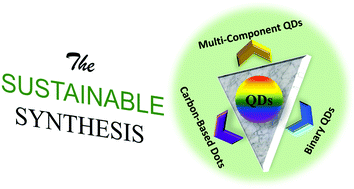A review on sustainable synthetic approaches toward photoluminescent quantum dots
Abstract
Photoluminescent quantum dots (QDs) with unique structures and excellent optical attributes have received much interest owing to their extensive applications. In this review, various classes of QDs with different compositions (such as carbon, binary components, and multiple components) have been selected to systematically summarize the green synthesis approaches to obtain QDs. Various liquid-phase chemical strategies based on “top-down” and “bottom-up” approaches have been proposed for carbon-based dots (CDs), with emphasis on “bottom-up” approaches using biomass materials as the carbon source. Green synthesis strategies for binary QDs (BQDs) focus on the use of green solvents and design of biological organisms. Among them, the use of various biological organisms as green reactors to synthesize BQDs without chemicals is a better option than other synthetic strategies. The green synthesis of multi-component QDs (MQDs) using partial substitution of green capping ligands, simple operation, and mild reaction conditions is also summarized, especially for perovskite QDs. In particular, the formation mechanisms, advantages, and limitations are discussed for each type of QD in these green synthetic strategies. Finally, the remaining challenges and future prospects of green synthetic strategies to obtain photoluminescent QDs are summarized.

- This article is part of the themed collection: Green Chemistry Reviews


 Please wait while we load your content...
Please wait while we load your content...